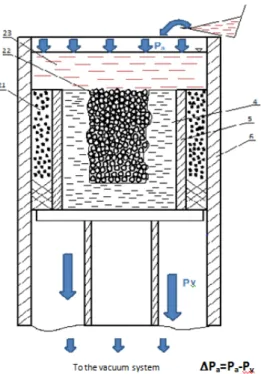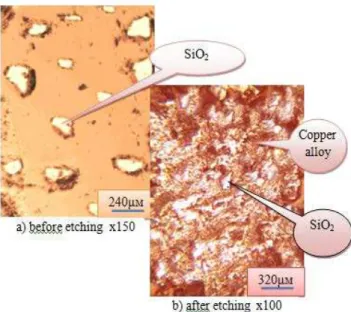Production of Decorative Cast Metal Matrix
Composites with a Complex Relief and
Nonmetal Reinforcement Phase
Daniela Spasova
Technical University of Varna, Materials Science and Technology department – Varna, Bulgaria
Abstract: The present paper is relevant to the research of possibilities for the production of decorative complex relief metal matrix composites (MMCs) of the “invitro” type, with unformed and unchanging reinforcement (strengthening) phase in the process of creating a composite. The research on the methods of metal matrix composites development in this paper has been brought to the application of different space vacuum schemes for composite synthesisof vacuuming the space for composites synthesis by using the notion of the “capillary forming”. In this method the metal matrix (copper alloy melt) was infiltrated in the space between the pellets of reinforcement phase (quartz particles – SiO2), whereas the classical method adopted for the
obtaining MMCs “in vitro”, uses a mechanism of forced insertion of the reinforcement phase into the ready for use melt, followed by homogenization of the composite structure.
In the particular case, because the obtained composite will have a complex relief three-dimensional surface, the conditions for compacting the building phases in the three directions x, y, z should be virtually equalized. In order to accomplish the task set, a laboratory system is developed. The experiments were conducted with laboratory equipment elaborated on the base of another equipment for "capillary forming" with extra vacuum.
The structures of the obtained MMCs were tested by metallographic analysis.
Keywords: MMCs, copper alloys, quartz particles- SiO2, capillary forming, vacuum
DOI: 10.18421/TEM51-13 https://dx.doi.org/10.18421/TEM51-13
Corresponding author:
Daniela Spasova :Technical University of Varna, Bulgaria
© 2016 Daniela Spasova, published by UIKTEN. This work is licensed under the Creative Commons Attribution-NonCommercial-NoDerivs 4.0 License. The article is published with Open Access at www.temjournal.com.
1. Introduction
One of the contemporary trends in the development of materials technology is manufacturing of metal matrix composites (MMCs) which significantly exceed the performance characteristics of metals and alloys i.e. fire-resistance, hardness, relative strength in particular. Generally, metal composites form a heterogeneous system consisting of a relatively homogeneous metal base (matrix) to which by the means of different technologies a reinforcement phase is added and distributed, distinct in type, form, content and certain characteristics [2].
The physicochemical interactions of the matrix and the strengthening components in these composites take place due to diffusion and chemical reactions. This determines the research of universal technologies, the great variety of these materials and the need of technological procedure optimization of composites production.
The research conducted on the production methods of MMCs has led to the application of different schemes of space vacuum aiming at the synthesis of complex relief composites using the concept of the ‘Capillary forming’ method [1].
2. Exposition
The purpose of the experiments conducted is the synthesis and research of new multiphase composites with controllable geometry of the reinforcement phase and metal matrix using the potential of capillary forming method. In this case, the process is related to the cast metal composites production of the ‘in-vitro’ type with copper alloy metal matrix and nonmetal reinforcement phase of quartz particles (SiO2). One of the advantages is that
the composite synthesis takes place at temperatures substantially lower than the melting point of the reinforcement phase elements. Another advantage is that the production of single blanks is economically viable since the equipment is easy to be prepared implementing the conventional methods of mould production. The synthesis of the cast composites takes place into these moulds.There isn’t a special need for the mouldsto be metallic. They can vary according to the specific case, e.g. they can be either ceramic, or with clay and concrete in their composition.
2.1. Experimental procedure
According to the classical method of ‘in vitro’ cast composites, a mechanism is applied for the forceful introduction of the reinforcement phase in the prepared smelt and the subsequent homogenizing of the composite structure. In this case the process of mixture of the matrix and the reinforcement phase takes place following the principle of ‘Capillary forming’. First, the reinforcement phase is put in the mould (quartz particles – SiO2). Then, the metal
matrix (copper alloy) in smelt form is infiltrated forcefully in the space among the metal particles by vacuum. Bearing in mind that the new composite will have a complex relief, three-dimensional surface, it is necessary to make the conditions of phase thickening equal along the three directions x, y, z. A laboratory device has been developed for the purposes of this task. The principle scheme of the device is shown in Fig.1.
The principal element of this scheme is the mouldingflask developed, where the mouldingflask vacuum takes place in three directions. This effect is achieved by perforating the main mouldingflask. Thus the pressure in the mould becomes equal along the side surfaces and the lower surface which acts as extra thickening of both the smelt and the constituents of the composite.
Figure 2. Illustrates then additional seal of the melt
A number of experiments have been conducted on the production of cast metal composites with copper alloy as a matrix and quartz particles (SiO2)
as a reinforced phase agent. The experiments have been carried out using the laboratory device described. The composites are with complex relief and they are shaped according to melted models in ceramic moulds using liquefied mixtures characterized by good strength properties and gas permeability. Two types of MMCs production have been tested. In the first variant the reinforcement phase particles (quartz particles - SiO2) are put into
the moulding flask, then the flask is put in the device and is heated up to 1100° C, after that the molten copper alloy (the matrix) is poured over the mould. During this process of interaction between the reinforcement phase and the matrix, the melt starts moving towards the sides of the mould thus almost the whole surface of the new composite contains the metal matrix.
In the second variant the metal matrix is produced in two stages. During the first stage quartzparticles(SiO2) and copper alloy particles are
mixed in the mould flask, then the mould is put in the device and is heated up to 1100° C, thus the copper alloy particles melt and wet the reinforcement phase. During the second stage above the two-phase mixture (melt and reinforcement phase), copper alloy melt is added resulting in additional compression of the new composite and consequent infiltration of the melt in the free spaces among the reinforcement phase elements.
From the experimental samples obtained specimens for micro-structural analysis have been provided. The metallographic specimens have been tested with a metallographic microscope ‘Neophot 32’.
2.2. Results and analyzing.
The results of the experiments conducted confirm to a great extent the existence of possibilities for the production of decorative MMCs with a complex relief by implementing the capillary forming principles. The experimental laboratory device has been used for the production of samples of complex relief MMCs with a reinforcement phase SiO2and copper- alloy matrix of the ‘in vitro’ type.
As it has been stated above the experiments were conducted in two ways.In the first variant the matrix (copper alloy melt) has been infiltrated in the space among the reinforcement phase particles (quartz particles - SiO2) but at this stage this variant is
considered as a failure since in the number of the experiments conducted unfilled areas in the mould have been observed (Fig.3).
The second variant with the metal matrix constructed in two stages, has been more successful. In this variant the composite has been created by the movement of the metal matrix in the small cavities of the reinforcement phase.
Figure 3.Microstructures before etching of the MMCs obtaining by the first variant.
This variant of mixing the two phases has proved as highly effective since the melt moves in short distances in the spaces of the reinforcement phase. In Figure 4 it is shown that the application of that MMCs production method has been successful resulting in a good quality infiltration of the smelt in the capillary cavities formed among the
80
μм
SiO
2Figure 4.Microstructures of the MMCs obtaining by the second variant.
Based on the experiments conducted on the composite production with a copper alloy matrix and a reinforcement phase quartz particles SiO2, a blank
with a complex surface relief has been obtained as a result (Fig.5). The figureand the visual observations of the surfacehave shown that due to the properly selected mode of interaction between the matrix and the reinforcement phase, a complex relief composite has successfully been produced in a mould with liquefied mixture. This mould can be easily reproduced in melting, elastic and other models, thus the production of complex relief composites is economically viable even for single pieces.
Fig.5 Picture of the obtained complex relief MMC with copper alloy matrix and
glass particles reinforcing phase.
The results obtained have been encouraging as far as the production of such complex relief MMCs is concerned. The advantage is that the MMCs have been produced in foundry moulds constructed with fire resistant materials not as in the conventional methods of metal. This type of moulds, made of ceramic liquefied mixtures, can be used for additional compressions thus making the two constituent phases more dense.
3. Conclusion
After the experiments conducted, based on the results obtained, the following more important conclusions can be drawn:
1. The scheme applied to the capillary forming reveals the opportunity of production of innovative complex- relief metal composites (MMCs) with decorative and artistic value.
2. The experiments conducted with the specially devised for the purpose equipment show that the specimens (the composites) with copper alloy metal matrix and reinforcement phase (quartz particles - SiO2) realize the geometry of the models used almost
100%.
3. The production of single blanks is economically viable, since the equipment is easy to be prepared by implementing the conventional methods of foundry mould production (ceramic, or with clay and concrete in their composition) and then the synthesis of the cast composites under consideration in these moulds.
4. The methodology developed for the preparation of complex-relief moulded composites (MMCs) provides good results in relation to the infiltration of the matrix (the melt) among the capillary cavities formed by the reinforcement phase particles in the volume of the composite, and as a result the areas with volume defects (pores,draws) have been minimized.
References
[1]. R.Radev, D.Spasova, N.Atanasov, R.Ivanova, Patent BG 65955 B1, 2010
[2]. D. Spasova, Radev R.., Atanasov N., (2015) “Investigate the Receiving of MMC with Metal Matrix Al and Fe Reinforcement Phase“. Machines, Tehnologies, Materials, (4/2015), 28-31
[4]. Moutsatsou A., Grigorios S., “Synthesis of Aluminium-based Metal Matrix Composites(MMCs) with Lignite Fly Ash as Reinforcement Material”,2009 World of Coal Ash Conference- May,2009 in Lexington, KY, USA, p138-146.
[5]Yılmaz, O., & Buytoz, S. (2001). Abrasive wear of Al
2 O 3-reinforced aluminium-based MMCs. Composites
Science and Technology, 61(16), 2381-2392.
[7] Thostenson, E. T., Ren, Z., & Chou, T. W. (2001). Advances in the science and technology of carbon
nanotubes and their composites: a review.Composites
science and technology, 61(13), 1899-1912.
[8] Dobrzański, L. A., Kremzer, M., & Nagel, A. (2007).
Application of pressure infiltration to the manufacturing of aluminium matrix composite materials with different reinforcement shape. Journal of Achievements in Materials and Manufacturing
Engineering, 24(2), 183-186.
[9] Leon, C. A., & Drew, R. A. L. (2000). Preparation of nickel-coated powders as precursors to reinforce
MMCs. Journal of Materials Science, 35(19),
4763-4768.
[10] Wu, Y., & Lavernia, E. J. (1992). Strengthening
behavior of particulate reinforced MMCs. Scripta

